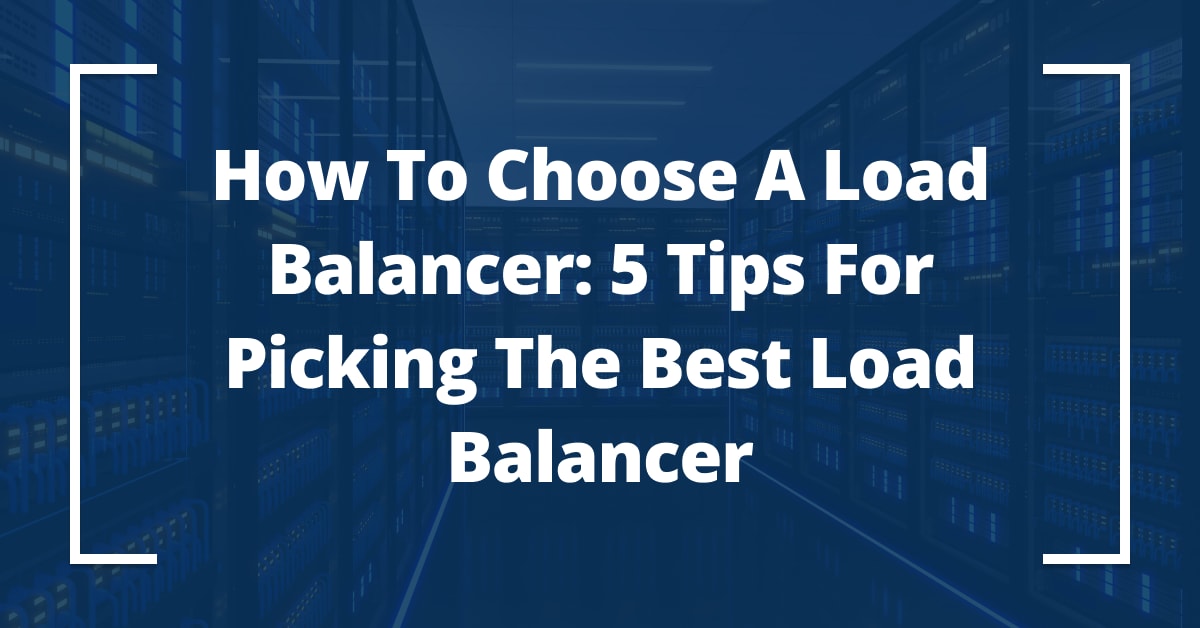
[ad_1]
In today’s fast-paced and highly demanding digital landscape, consumers expect web applications to be fast and reliable. According to John Mueller, a Search Advocate at Google, the ideal load speed should be about 2 – 3 seconds. Choosing the right load balancer is crucial for ensuring optimal performance, reliability, and scalability of web applications.
With several load-balancing solutions available, selecting the best one for your web app needs can be a challenge for some. This guide provides you with essential tips that will help navigate you on how to choose a load balancer.
What Is a Load Balancer?
In web applications, a load balancer is a crucial component of the app’s cloud infrastructure that distributes incoming traffic across multiple servers or resources. Its primary function is to distribute incoming traffic across multiple servers or resources, ensuring efficient utilization, improved performance, and high availability of web applications.
Without a load balancer, traffic distribution becomes uneven, leading to server overload and decreased performance. Acting as a traffic manager, the load balancer evenly distributes the workload, effectively preventing any single server from becoming overwhelmed.
It’s important to understand that load balancers can operate at different layers of the network stack, such as the application layer (Layer 7) and transport layer (Layer 4). They employ algorithms like round robin, source IP and URL hash, and randomized algorithms to determine how to distribute traffic.
Whether you are using VPS hosting or dedicated servers, implementing a load balancer is crucial to ensure optimal performance, efficient resource utilization, and a seamless user experience for your web applications.
Understand the 3 Different Types of Load Balancers
There are three major types of load balancers:
Application Load Balancer (ALB)
This is one of the most commonly used load balancers in modern web applications, microservices architectures, and containerized environments. Application load balancers operate at the application layer of the network stack. An ALB distributes incoming traffic based on advanced criteria, such as URL paths, HTTP headers, or cookies.
Network Load Balancer (NLB)
A network load balancer works at the transport layer and is responsible for distributing traffic-based network factors, including IP addresses and destination ports. Network load balancers do not consider any application-level parameters like content type, cookie data, headers, locations, and application behavior. These load balancers are commonly used for TCP/UDP-based (Transmission Control Protocol/User Datagram Protocol) applications. Examples of these applications include gaming servers, VoIP (Voice over Internet Protocol) services, and IoT (Internet of Things) applications.
Global Server Load Balancer (GSLB)
This load balancer type ensures optimal performance by distributing traffic across multiple data centers or geographically dispersed locations. It is ideal for globally distributed applications, content delivery networks (CDNs), and multi-data center setups. A GSLB extends the capabilities of generic L4 and L7 over several data centers, allowing traffic to be optimally distributed. The key factors considered by GSLBs include location, server health, and network conditions.
Load balancers can also be categorized into static, dynamic, and adaptive load balancers. Here’s how they differ:
- Static load balancers distribute incoming traffic across servers or resources using predefined rules or configurations. They are suitable for applications with consistent and predictable traffic patterns where workload distribution remains relatively stable.
- Dynamic load balancers have the ability to adapt and make real-time adjustments to traffic distribution based on the current status of the servers. So, they consider server health, response times, or current workload when distributing traffic.
- Adaptive load balancers integrate the capabilities of static and dynamic load balancers. Initially, they can distribute traffic based on predefined rules but can also adapt their balancing strategy in response to changing conditions of the servers, network, and user behavior.
Why You May Need a Load Balancer
Load balancers are very crucial in ensuring the optimum performance of web applications. Here are some reasons your web app may need a load balancer:
- Scalability – As the demand for your application goes up, load balancers allocate the workload or traffic appropriately across different servers. This prevents any single server from becoming overwhelmed or failing. Ultimately, this enables your app to handle a higher volume of traffic.
- High availability – Since load balancers prevent a single server from being overwhelmed, they enhance the reliability and availability of your application. They can also route your traffic to available servers in case one server becomes unavailable due to hardware failure or maintenance.
- Performance optimization – Load balancers evenly distribute incoming requests, which helps to optimize performance and improve response times. They can direct traffic to servers that have lower utilization or are geographically closer to the user, reducing latency and enhancing user experience.
- Health monitoring and failover – Most load balancers are also designed to continuously monitor the health and availability of backend servers. They perform periodic health checks to ensure all servers receiving traffic are in the best possible condition.
Tips for Picking the Best Load Balancer: How To Choose a Load Balancer
When choosing a load balancer for your web application, here are some factors that you must consider:
Consider Your Business Needs
First, you need to evaluate your specific business and application requirements. You must determine the details of the traffic your app will be handling and the expected volume. Different load balancers excel in different scenarios, such as handling HTTP/HTTPS traffic, TCP/UDP-based applications, or global distribution. Having these details at the back of your mind will help you select the load balancer that aligns with your requirements.
Assess Criticality and Security
When choosing a load balancer, it is crucial to determine if your system is highly critical or sensitive to downtime or unauthorized access. If security and minimizing downtime matter to you, be sure to prioritize load balancers with robust security features, such as SSL/TLS encryption, WAF (Web Application Firewall) capabilities, or authentication mechanisms.
Consider Flexibility and Scalability
It would be best to choose a load balancer that can accommodate changes and adjustments as your application evolves over time. To that end, it should give you the option to add or remove servers easily and be able to adapt to changing traffic patterns. The key features you should look for include auto-scaling and dynamic configuration updates.
Compare Price Points and Features
Operating a load balancer can significantly impact the overall cost of running your web application. With this in mind, it’s crucial to evaluate the pricing structure of different load balancers and compare them based on their features and value. You should also consider other factors, such as upfront costs, licensing models, and ongoing maintenance fees. You should also consider any potential additional charges for advanced features or customer support.
Consider Performance and Monitoring Capabilities
When considering a load balancer, especially for VMware hosting, it is essential to thoroughly evaluate its performance and server monitoring capabilities. Look for features such as intelligent traffic distribution algorithms, connection pooling, and health monitoring. By opting for a load balancer that offers comprehensive monitoring and reporting capabilities, you can effectively identify performance bottlenecks, troubleshoot issues, and optimize your application’s overall performance.
Final Thoughts
When choosing a load balancer, you need to consider your business needs, assess the type and volume of traffic, evaluate criticality and security requirements, seek flexibility and scalability, and compare price points and features. By following these steps, you will be able to identify the load balancer that best suits the specific needs of your web application or website. Remember, choosing the right load balancer will ensure optimal performance, high availability, and a flawless experience for your users.
Are you ready to unlock the true potential of your web application and deliver an exceptional experience to your users? Discover the power of Liquid Web’s load balancer solutions, designed to distribute incoming traffic seamlessly across multiple servers or resources. With advanced algorithms and customizable options, you can achieve efficient resource utilization and a flawless user experience.
[ad_2]
Source link






